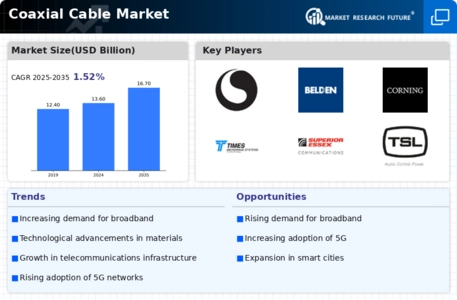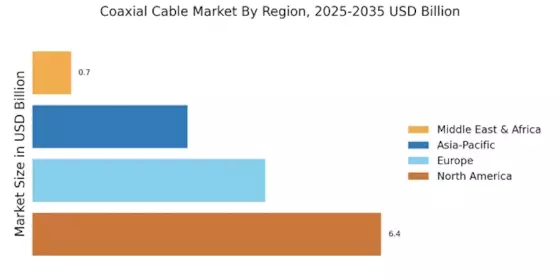Emergence of Smart Technologies
The Coaxial Cable Market is increasingly influenced by the emergence of smart technologies, which require reliable and high-performance cabling solutions. The proliferation of smart homes, IoT devices, and automated systems is driving the need for efficient data transmission. Coaxial cables, known for their durability and performance, are well-suited for these applications. As smart technologies continue to gain traction, the demand for coaxial cables is likely to rise, as they provide the necessary bandwidth and reliability for seamless connectivity. Market analysts predict that the integration of coaxial cables in smart technology applications will contribute to a significant portion of the overall market growth in the coming years.
Rising Demand for High-Speed Internet
The Coaxial Cable Market is witnessing a notable increase in demand for high-speed internet services. As more consumers and businesses seek faster and more reliable internet connections, coaxial cables are becoming a preferred choice due to their ability to support high bandwidth. Recent statistics indicate that the number of broadband subscribers has increased significantly, with many regions reporting growth rates exceeding 10% annually. This trend is particularly evident in urban areas where the need for robust internet infrastructure is paramount. The Coaxial Cable Market is poised to benefit from this rising demand, as service providers invest in upgrading their networks to accommodate higher data rates. Consequently, the market for coaxial cables is expected to expand, driven by the necessity for enhanced connectivity solutions.
Growing Adoption of Cable Television Services
The Coaxial Cable Market is experiencing growth due to the increasing adoption of cable television services. As consumers continue to favor cable over other forms of media, the demand for coaxial cables remains strong. Recent data indicates that cable television subscriptions have seen a resurgence, with many households opting for bundled services that include internet and phone. This trend is likely to sustain the need for coaxial cables, which are integral to delivering high-quality video and audio signals. The Coaxial Cable Market is expected to capitalize on this trend, as service providers enhance their offerings to attract and retain subscribers, thereby driving further demand for coaxial cable solutions.
Technological Advancements in Coaxial Cable Market
The Coaxial Cable Market is currently experiencing a surge in technological advancements that enhance performance and reliability. Innovations in materials, such as improved insulation and shielding, are leading to better signal quality and reduced interference. The introduction of high-frequency coaxial cables is particularly noteworthy, as they cater to the increasing demand for high-speed data transmission. According to recent data, the market for high-frequency coaxial cables is projected to grow at a compound annual growth rate of approximately 6% over the next five years. This growth is driven by the rising need for efficient communication systems in various sectors, including telecommunications and broadcasting. As technology continues to evolve, the Coaxial Cable Market is likely to adapt, ensuring that it meets the demands of modern applications.
Increased Investment in Telecommunications Infrastructure
The Coaxial Cable Market is benefiting from increased investment in telecommunications infrastructure across various regions. Governments and private entities are recognizing the importance of robust communication networks, leading to substantial funding for upgrades and expansions. Recent reports suggest that investments in telecommunications infrastructure are projected to reach several billion dollars over the next few years. This influx of capital is likely to stimulate demand for coaxial cables, which are essential for connecting various components of the network. As the industry evolves, the Coaxial Cable Market is expected to play a crucial role in supporting the growing infrastructure needs, particularly in developing regions where connectivity is still being established.


















Leave a Comment